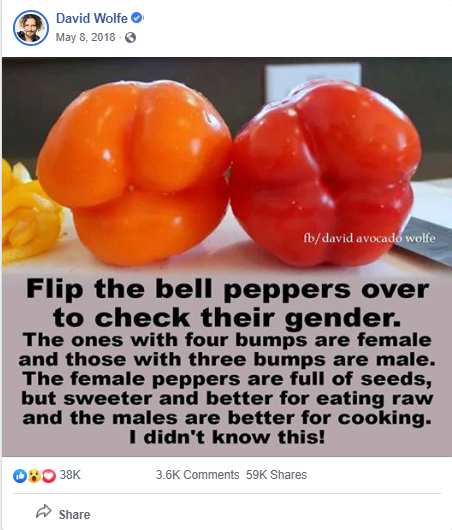
No, bell peppers don’t have a gender
- This article is more than six years old.
- Published on September 3, 2019 at 06:35
- 2 min read
- By AFP Australia
This Facebook post was published in May 2018 and has been shared 59,000 times since.
The meme’s text reads: “Flip the bell peppers over to check their gender. The ones with four bumps are female and those with three bumps are male. The female peppers are full of seeds, but sweeter and better for eating raw and the males are better for cooking. I didn’t know this!”
Below is a screenshot of the post:

Other posts with similar claims can be found on Facebook here and on Twitter here.
The long-running claim is false, as bell peppers do not have a gender.
In an August 28, 2019, email to AFP, Zhonghua Chen, associate professor at Western Sydney University’s School of Science and Health, explained why:
“Capsicums (Capsicum annuum), also called sweet peppers, have individual flowers containing both male parts (pollen-producing anthers) and female parts (stigma and ovary). This means that all capsicums are ‘fruits’ that form from the fertilisation of the ovary and the fruit itself has no ‘gender’. The fruit contains several hundred seeds which are capable of producing new plants with both male and female flower parts in the one flower.”
Chen said the number of bumps in a bell pepper has no correlation to flavour, seed production or sensory attributes of the fruit. The number of bumps may reflect natural variation in the fruit’s development and size, he added.
The number of seeds in the fruit doesn’t affect the flavour, either.
“Research into the flavour of capsicums has mostly focused on the differences between sweetness (sugar levels) and sourness (acidity). Unlike hot chilis, capsicums (sweet peppers) contain little capsaicin (the spicy compound), so their flavour is the result of volatile chemical compounds, sugars, carbohydrates and the different textures of the smooth skins and the rough softer flesh inside,” Chen said.
“The number of seeds does not affect flavour, but may reflect the plant’s vigour, the quality of pollination and even the grade of the fruits as each seed is the end result of a pollination process.”
Oregon State University has also debunked the false claim here.
Copyright © AFP 2017-2025. Any commercial use of this content requires a subscription. Click here to find out more.
Is there content that you would like AFP to fact-check? Get in touch.
Contact us
